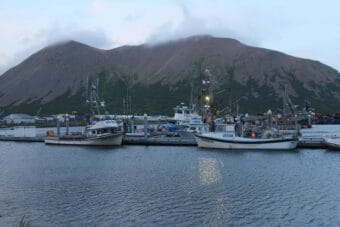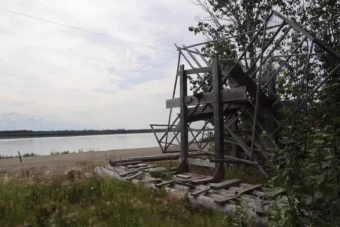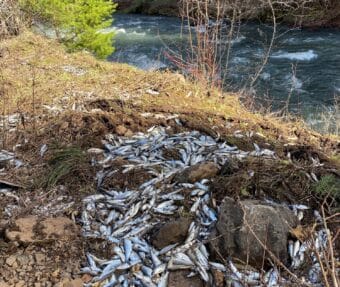
(Sage Smiley/KSTK)
This summer, Canada closed most of British Columbia’s commercial salmon fisheries. Declining stocks were to blame for the drastic conservation measures. Southeast Alaska shares coastline and transboundary rivers with B.C. — so what could this mean for the region?
The Department of Fisheries and Oceans Canada — the federal agency that manages Canada’s fisheries — effectively ended the 2021 commercial salmon season on the West Coast in late June.
Seafood Alliance Executive Director Christina Burridge says Canada’s fishing industry was stunned.
“First Nations have harvested salmon forever. And post-contact, salmon canneries are what in the sense built this province. To be now in this situation seems really tragic to me,” she said.
The closure came just weeks after Canada announced a $535 million plan to revitalize its flagging Pacific salmon stocks in B.C. and Yukon Territory.
But Burridge says the closure erased most of the Canadian fleet’s entire year.
“The minister’s announcement and most subsequent media coverage has said that it’s 60% [of B.C.’s commercial fisheries closed],” she explains. “In terms of the number of actual fisheries, that is correct. In terms of landed volume, it is 80%. And for gillnet fisheries, it’s about 95%.”
Canadian government officials say this has been a long time coming.
“I know it was a bit of a surprise to some — to many — but those that have been close to the industry and close to Pacific salmon fisheries here, at least and [along] the B.C. coast recognize that the overall level of catch has been dropping significantly for some time,” Sarah Murdoch said. She’s the senior director of Canada’s Pacific Salmon Strategy Initiative, which aims to shape Canadian fisheries policy moving forward.
So what does Canada’s salmon shutdown mean for its Alaska neighbors?
From a market standpoint, not much, says McKinley Research analyst Dan Lesh in Juneau.
“Alaska dwarfs B.C.,” Lesh explains, “And so anything that happens in those markets is not going to be a big impact on our fisheries. For instance, Canada produces only about .017%, so less than .1%, of sockeye globally — that’s as of 2019.”
B.C.’s largest wild salmon market is chinook: about 14% of the global market in recent years. But its shares of the other four salmon species represent less than 2% of worldwide production.
So, while the closures are devastating for B.C., they shouldn’t move world markets.
Still, Lesh says the shutdown isn’t good for the perception of wild salmon as a sustainable product. Concerns about declining food sources for killer whales have prompted some in the Pacific Northwest to avoid chinook salmon.
“Of course, that doesn’t make sense for protecting the orcas,” Lesh said. “The salmon are coming from a different area and a different stock. But so that’s my broader concern with some of these declining stocks on Alaska’s market.”
State fisheries managers say B.C.’s experience isn’t likely to be repeated in Alaska. Southeast management biologist Troy Thynes says Alaska has safeguards in place to keep salmon runs from dropping too far, allowing spawning fish to keep moving up rivers and streams. Drastic measures like widespread closures aren’t in the nature of Alaska’s dynamic management, where biologists can time openings at will.
“When Fish & Game is concerned about stocks — if a stock is not making escapement after a number of years, those types can be listed or recommended to the Board of Fisheries as a stock of concern. And we do have several stocks of concern that are in Southeast Alaska right now,” Thynes said.
The chinook on the transboundary rivers Unuk and Chilkat are among the current Southeast stocks of concern. Stikine and Taku kings — both also transboundary rivers — are proposed to be added to the list.
Burridge, with the B.C. Seafood Alliance, says she admires Alaska’s proactive strategies, which involve long-range management plans and a lot of public input.
“Basic things like stock assessments in Canada have been starved for at least two decades,” Burridge said. “And I think that’s one of the reasons why we’re looking at these closures is that the work simply hasn’t been done. I suspect most Alaskans would agree with me that the foundation of good fisheries management is good stock assessment.”
Burridge says the sacrifice being made by B.C. fishermen will only be worthwhile if there’s more investment in research and restoration of fish habitat.
“Salmon, as you know, are doubly vulnerable because they depend both on the marine environment and the freshwater environment,” she said. “And we have certainly compromised the freshwater environment here and particularly in southern B.C.”
But about a third of Canada’s $500 million salmon rescue plan will likely be spent buying out permit holders.
“I’m not for a moment saying that we should go fishing because people need to go fishing,” Burridge said. “We have to be extremely careful and cautious, but this is very, very devastating. And I think while some of the closures were probably necessary, many it seems to me are just putting the burden on the commercial sector rather than putting it on other sectors.”
U.S. states and Canadian provinces work cooperatively to co-manage transboundary salmon runs through the Pacific Salmon Treaty. But the Canadian government says the shutdown on their end likely won’t affect current allocations, as the treaty won’t be renegotiated until 2028.



